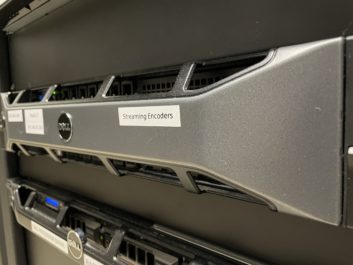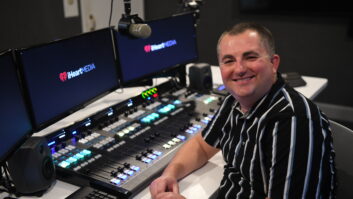For radio stations, streaming of our programming has changed considerably over the past decade.
In the early days, it was a novelty. It represented just another way for listeners to “tune in” to their favorite stations. There was little in the way of value in an internet-delivered stream, but many stations got on the bandwagon for various reasons, including (and perhaps especially) because the competition was doing it.
Those early streaming efforts were … primitive (to put it nicely). Bit rates were often low because bandwidth costs were so high in those days, and the streams sounded, well, not great. They were full of artifacts, and many exhibited that watery sound that was and is so common to low bit rate streams. Most were either unprocessed or poorly processed — wrongly processed is probably a better descriptor, and that didn’t help matters much on the listener’s end.

As time went on and bandwidth costs came down, bit rates were improved and things stated sounding better. We began to figure out how to monetize our streams to make them pay for themselves at the very least and be somewhat profitable at best. This roughly coincided with reduced costs for mobile data plans, making it possible for listeners to connect to our streams using their mobile devices.
Squeaks and chirps
We started figuring out how to process our streams right, using processing algorithms specifically created for reduced bit rate audio.
This made a big difference in our 32- and 64-kbps MP3 and AAC streams; they became downright pleasant to listen to. Gone were the watery sound and chirpy, squeaky artifacts. And because we weren’t trying to beat the guy(s) across town in a loudness war, our streams could actually have some dynamic range.
With the advent of hybrid radio, the quality of our streams has taken on a whole new level of importance. When the blend to the stream occurs in the listener’s radio, we want to avoid big difference in sound quality. It should be imperceptible, or almost so. The challenge is much the same as it has been for hybrid HD Radio for the past 15+ years: The blend has to sound good.
Streaming encoders have come a long way, too. Most, as far as I can tell, are still software encoders running on the station’s own hardware, but both the encoding software and the hardware are getting better and better.
In addition to traditional sound cards ranging from under $50 to over $1,000, stations with AoIP studio infrastructure have the option to feed their encoders via IP using PC drivers compatible with whatever AOIP system they are using.

In the bigger markets, my company employs Dell Precision rack-mount workstations with some horsepower, dual-port NICs and employing multi-channel AoIP drivers to produce the streams. These machines can easily handle streams for multiple stations with multiple streams for each station. Streaming service for our stations is provided by Triton, and we use their proprietary encoder software on these workstations.
Purpose-built hardware encoders are now available from various manufacturers that will accept a variety of input sources, including AoIP. These encoders will produce multiple streams in different formats and with different data rates. Some include integral audio processing, providing a “one-stop” encoding solution.
Making it pay
As noted, monetizing our streams is important in many stations. Preroll and midroll audio or video ads, ad replacement and programmatic ad sales are elements that we have to deal with in many cases. Some of those things require special triggers from our playout systems, and that can be really tricky.
RIAA reporting for royalties is another important element that we have got to get right. Underreporting or missed reporting can get us in hot water legally; overreporting can cost us in unnecessary royalties. This reporting is a function of metadata export from our playout systems.
Some of the same metadata export is used to provide title/artist display on media players, and even to trigger lookup of album art for player/app displays, another reason to get it right. Listeners get irritated when incorrect information — or no information — is displayed. I know I do.
On a related note, stream listeners who don’t show up in the Nielsen data don’t count, so we’ve got to get our watermark encoding right. Program directors and station managers get really irritated when PPM doesn’t pick up on listeners that we have.
In the current issue of RWEE, Rick Bidlack, a development engineer at Wheatstone Corp., walks us through the building blocks of a stream.
There’s a lot at work here, from the playout system, the encoder, audio processing, metadata aggregation and conversion, and transmission to the masses. There are plenty of places for things to go wrong, but the better our understanding of the signal flow, the better equipped we as broadcast engineers will be to deal with it.
I remember a decade or more ago pulling out my iPhone and describing it to the president of our company that this was the “transistor radio” of the future. In a lot of ways, I missed that prediction by quite a bit; nobody walks around with an iPhone in their shirt pocket audibly playing a radio station stream. But in some ways I was right. There are plenty of folks using their smartphones to stream audio to their Bluetooth earbuds, and there are just as many that play streams through a Bluetooth-connected audio system, in cars, homes, even airplanes. And listeners in cars equipped with hybrid radio will sometimes listen to our streams and don’t even know it.
The bottom line for us is that more than ever, our internet streams have got to be right. They have to be reliable, meaning that someone (or something) has got to monitor them to be sure they are up. They have to sound good, be artifact-free and carry the correct metadata. Ad replacement has to be smooth and seamless, with overlays fitting exactly. And watermark encoding has got to be done right, too.
There is a lot at stake. We can’t afford to be anything but diligent.
Read more about streaming trends and best practices in Radio World’s free ebook “Streaming for Radio in 2021.”
Cris Alexander, CPBE, AMD, DRB, is director of engineering for Crawford Broadcasting and technical editor of Radio World Engineering Extra.







